Physical Address
304 North Cardinal St.
Dorchester Center, MA 02124
Investigation of sudden cardiac death (SCD), like all other sudden, unexpected, or unnatural death, relies heavily on a thorough and comprehensive investigation of the circumstances surrounding death, including a scene investigation, interview with family and friends regarding family history and social history, collection of relevant medical history from a treating physician, and review of the medical records. Interviews with friends and family regarding new or changed symptoms preceding death may be key to understanding the pathogenesis of death. Specifically regarding SCDs, a comprehensive report of the activities, complaints and behaviors before and during death are critical. Many causes of SCD have no structural changes identifiable at autopsy on gross examination or even upon microscopic examination. Sometimes, it is the lack of findings that is significant and identifies the cause of death suspected from the circumstances at death.
The scene investigation should document the particulars of the body and the surroundings. The position of the body and any evidence of disruption of the surroundings should be noted. Any medications including dosage, number of pills prescribed and number of pills remaining, drugs and drug paraphernalia, alcohol, and tobacco present at the scene should be thoroughly recorded. Any medical paperwork should be examined for diagnosis and physician information, and family members or friends present at the scene should be questioned about the decedent’s medical history and treating physicians.
Without a thorough investigation, including the circumstances surrounding death as well as a comprehensive medical, social, and family history, the specific cause of an SCD may go undiagnosed. Often at the time of autopsy, little of this information is known. However, additional information can be gathered in the days to weeks following the autopsy while awaiting histopathology slides and toxicology results. Asking family members and friends specific questions in an effort to gather significant family and social history, a list of recent complaints and medications, and a report of the circumstances at the time of death will elucidate much of the needed information to aid in the determination of the cause of an SCD.
If death occurs in hospital, the pertinent medical records and emergency response reports should be sent with the body for review prior to autopsy. A summary of the pertinent events, diagnoses, laboratory testing, radiology imaging, and operative events while in hospital may be very helpful, particularly if the hospitalization course is prolonged. A thorough medical history should be gathered from all available resources, including family, friends, and treating physicians. Asking detailed family history questions, rather than a general query into cardiac death, is likely to illicit the most useful information and give the most helpful clues to identify the cause of death. The social history, including use of drugs, alcohol, and tobacco, will identify substances that may play a role in death and may suggest or refute the suspicion of SCD. Certain illicit drugs and prescription medications may elevate blood pressure or induce cardiac rhythm disturbances. Obtaining a comprehensive list of illicit drug use and prescription medication use and misuse will guide appropriate toxicology testing to identify the presence of these substances in the body at the time of death; toxicology results can also inform the extent of histology sections necessary for establishing a diagnosis and ultimately establishing the cause of death in a timely and accurate manner .
Many changes and disease processes may be identified at autopsy that do not play a role in death and are not related to the cause of death. Common changes include artifacts related to resuscitative efforts and postmortem changes. Knowledge of the time course of medical intervention, the types of treatment used, and the responses received from the intervention may aid in interpretation of changes identified at autopsy. Likewise, knowledge of the position of the body when found as well as the state of decomposition changes, including livor mortis, rigor mortis, and algor mortis, will aid in interpretation of findings at autopsy.
Cardiopulmonary resuscitation (CPR) may cause devastating injuries to the chest, including the heart ( Figs. 22.1 and 22.2 ). Most common are small amounts of serosanguinous fluid in the pericardial space. Petechial hemorrhages may be seen over the pericardium or the epicardial surfaces of the heart as the result of small capillaries bursting from direct and indirect pressure placed on the heart during resuscitation. Contusions, or bruising, to the heart may be identified on the epicardial surface or may rarely involve the full thickness of the myocardium ( Fig. 22.3 ). Often, contusions involve the anterior aspects of the heart, but may also be seen on the posterior surfaces if resuscitation is aggressive or in patients who are coagulopathic. Histologic examination of the hemorrhagic wall may aid in determining that the hemorrhage is indeed postmortem and related to resuscitation rather than an antemortem myocardial infarct, as changes related to resuscitation should lack hypereosinophilia, contraction band necrosis, and infiltration of inflammatory cells. If spontaneous circulation is regained for a short time, contraction bands and hypereosinophilia may be identified, but infiltrating inflammatory cells are typically not present. Individuals who survive for hours after resuscitation may show patchy regions of myocardial necrosis, particularly around blood vessels where the reperfusion first occurs.
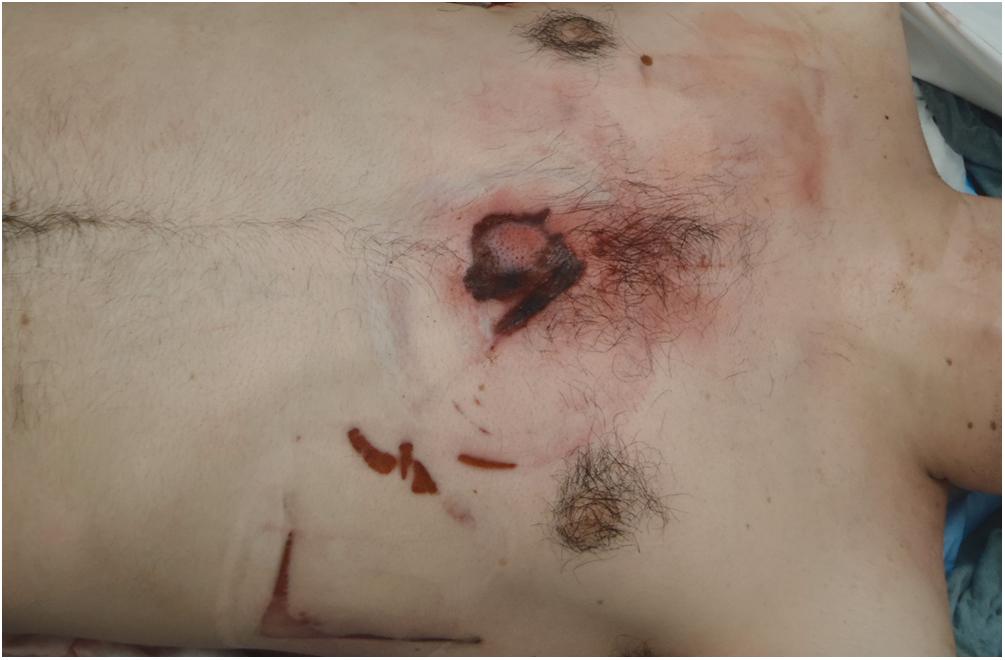
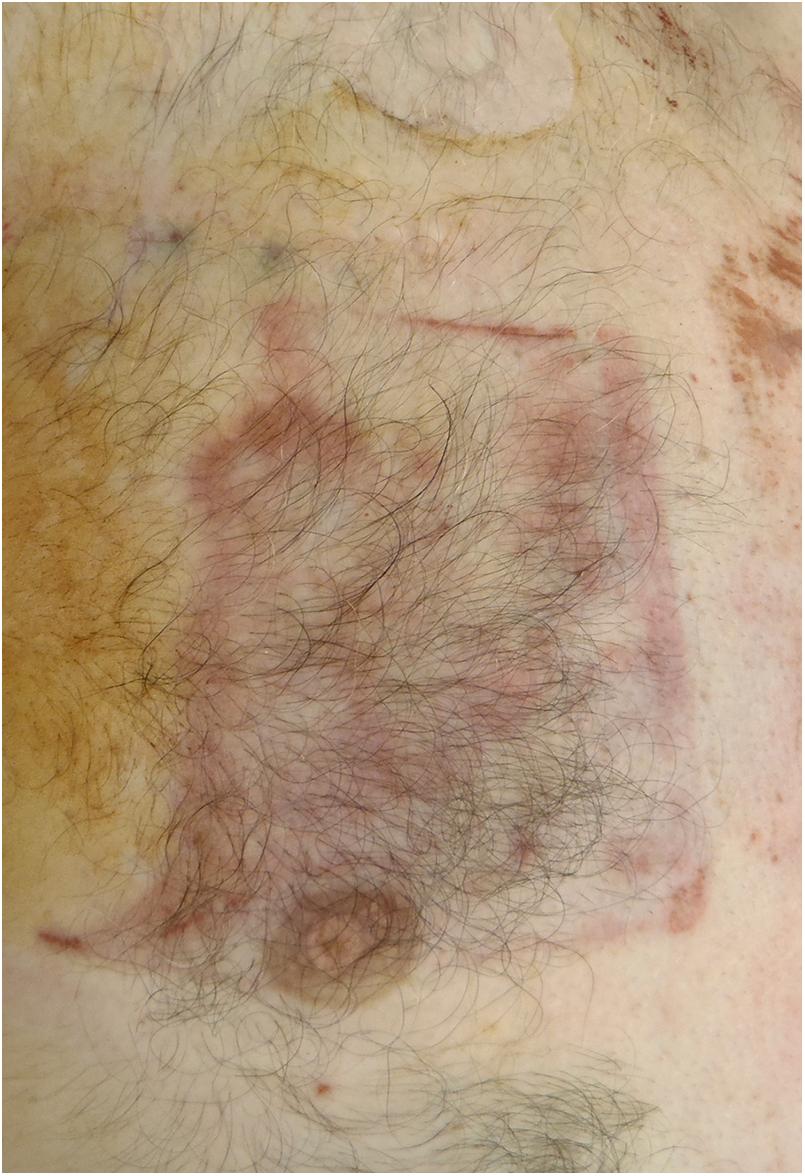
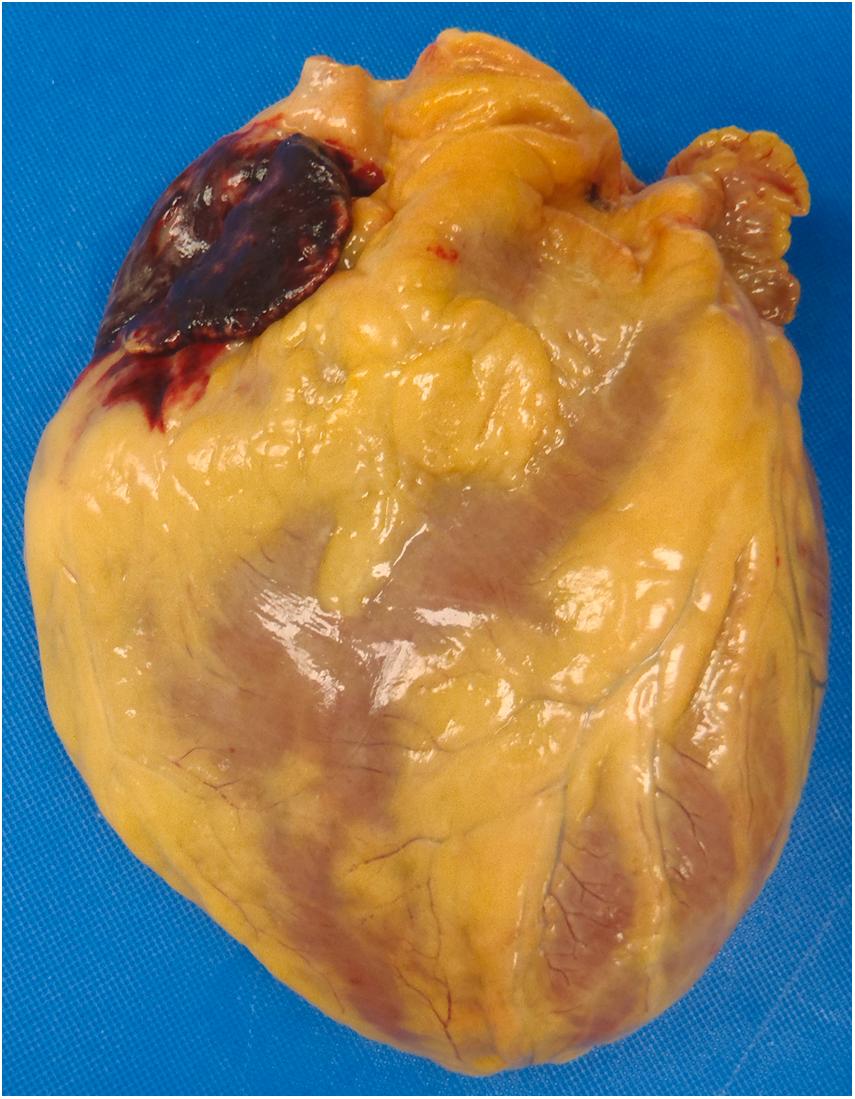
In addition to petechial hemorrhages and contusion, direct damage to the pericardium and heart may be caused by rib or sternal fractures, repetitively displaced during the physical compressions associated with CPR. Focal and minor to diffuse and extensive lacerations of the pericardium and heart may be present based on the aggressiveness of resuscitation, use of an automated resuscitative device, bone density status, and resultant fractures of the chest plate. Rib and sternal fractures are most commonly identified in older, osteoporotic patients or in younger patients who are osteopenic from a natural disease process such as cancer or malnutrition. Often, lacerations are surrounded by only focal, small amounts of hemorrhage; however, in coagulopathic decedents, the hemorrhage may be extensive .
Livor mortis, also known as lividity, is the settling of blood after death in gravity-dependent portions of the body, including in the organs. It is typically not as noticeable in the heart as it is in other organs such as the lungs. When present, it may cause concern for a large region of myocardial ischemia. Identification of discoloration over a broad continuous surface of myocardium should raise suspicion for gravity-dependent lividity and the location on the heart should be correlated with the presence and pattern of lividity identified in the other organs at autopsy, as well as the investigation notes regarding the position in which the body came to rest after death. Status of the lividity (blanching, slightly blanching, or nonblanching) at investigation as well as at autopsy, may also be useful. If a question remains in distinguishing lividity from myocardial ischemia, histology sectioning may aid in differentiating the two processes. In lividity, one would expect to see blood confined within the lumen of the blood vessels rather than spreading throughout the myocardium. More advanced decomposition-associated changes in the heart are typically putrefactive changes, brought on by bacterial destruction of tissues. This process results in gross, typically uniform softening and dark discoloration of the heart and vessels. The heart loses its muscular tone as the tissues break down and may appear dilated with a thick left ventricle appearing of more normal thickness. One should be cautious when interpreting cardiac dilatation in a decomposing heart and will be best served to interpret such a finding in the context of the prevailing forensic scenario. In addition to softening and discoloration, atherosclerotic plaques particularly in the coronary arteries may putrefy and be difficult to evaluate. A clinical history of atherosclerotic and/or hypertensive cardiovascular disease may aid in determining the cause of death and microscopic examination of the myocardium may also be helpful, revealing myocyte hypertrophy and/or perivascular and interstitial fibrosis, suggestive of antemortem hypertension and ischemia .
The cardiac pathologist may serve an important role as a consultant in the forensic setting. Evaluation of the heart and major vessels by an expert allows for thorough identification of preexisting pathology, accurate documentation of complex surgical procedures both recent and remote, and exploration of recent changes to the tissues. Accurate documentation of these factors will assist in identifying the mechanism which led to death. Additionally, this important information may help confirm reported events surrounding death. The medical examiner/coroner will utilize information from the cardiac pathology consultation with the circumstances surrounding death including other autopsy findings, toxicology results, witness statements, police reports, and scene investigation. Assimilation of all information will allow for a determination of the cause and manner of death.
While a decedent may have very significant cardiovascular pathology, this underlying disease may play no role in the cause and manner of death. For example, a person with significant coronary artery atherosclerotic stenosis may suffer a gunshot wound to the head during an argument and die. Though the underlying cardiac disease made that person susceptible to SCD, the gunshot wound was a significant intervening event, unrelated to the existing heart disease, which resulted in death. Some deaths, however, require more investigation of the preexisting cardiac disease, and highlight the necessity of a thorough cardiac examination, and the additional benefits of cardiac pathology consultation if needed. If this same person were to crash his car while driving and sustained injuries which may or may not be extensive enough to cause death, the examination of the heart may assist in determining if the crash occurred due to a cardiac related event or if underlying cardiac disease made the individual more susceptible to death from a less extensive injury. In this scenario, the findings would assist not only in determining the cause of death but also the manner of death. Identification of significant long-standing cardiac pathology may indicate that the crash was caused by some acute event that could not be documented at autopsy, such as a dysrhythmia or rapidly fatal myocardial infarct ; however, other circumstances may have led to the crash, such as driver error, mechanical issues, or dangerous driving conditions such as icy roads. The exact cause for the crash may not be definitively determined in such cases, but utilizing information from accident reconstruction investigators can aid in the ultimate determination. In these scenarios, the medical examiner or coroner would rely heavily on the cardiac pathology evaluation to understand the extent of the long-standing pathology, if there was a more acute pathologic process either independent of or related to the preexisting pathology, or if there is evidence of trauma to the tissues. Understanding these factors can allow for an understanding of the mechanism of death. Based on the examination, the medical examiner or coroner can determine the significance of these findings in the death. Critical trauma to the heart or major vessels with significant bleeding into the adjacent soft tissue indicates that the death was likely related to the motor vehicle crash. Identification of an acute pathologic process in the absence of significant injury would indicate that the crash was likely a secondary result of the acute pathology and the medical examiner/coroner would have to determine if the injuries from the crash were significant enough to have contributed to death.
Penetrating injuries of the heart and cardiac vessels may result from any object that pierces the organ, including fractured ribs, sharp objects such as knives, tools such as a screwdriver or a barbecue fork, and high-velocity blunt objects such as bullets. Stab wounds result from any sharp object penetrating into the skin, soft tissues, and organs with the injury deeper than it is wide on the surface of the skin. Such injuries most often result in death from hemorrhage into the pericardial sac with tamponade or from exsanguination due to extensive hemorrhage into the pleural cavities and soft tissues surrounding the pericardium. These injuries may involve the myocardium, the coronary arteries, or the great vessels. The size of the injury as well as the structures involved will determine the speed at which sufficient blood is lost to result in death. Accurate measurements of injury dimensions, location, and estimation of depth of penetration are often helpful in assessing the type of object causing the injury. Features of the object injuring the heart are often well preserved in the muscular heart, and often are consistent with or even more precise than measurements on the surface of the skin, which is subject to distortion from Langer’s lines ( Fig. 22.4A and B ). Injuries of the blood vessels can result in hemorrhage or introduction of air into the cardiovascular system ( Fig. 22.5 ).
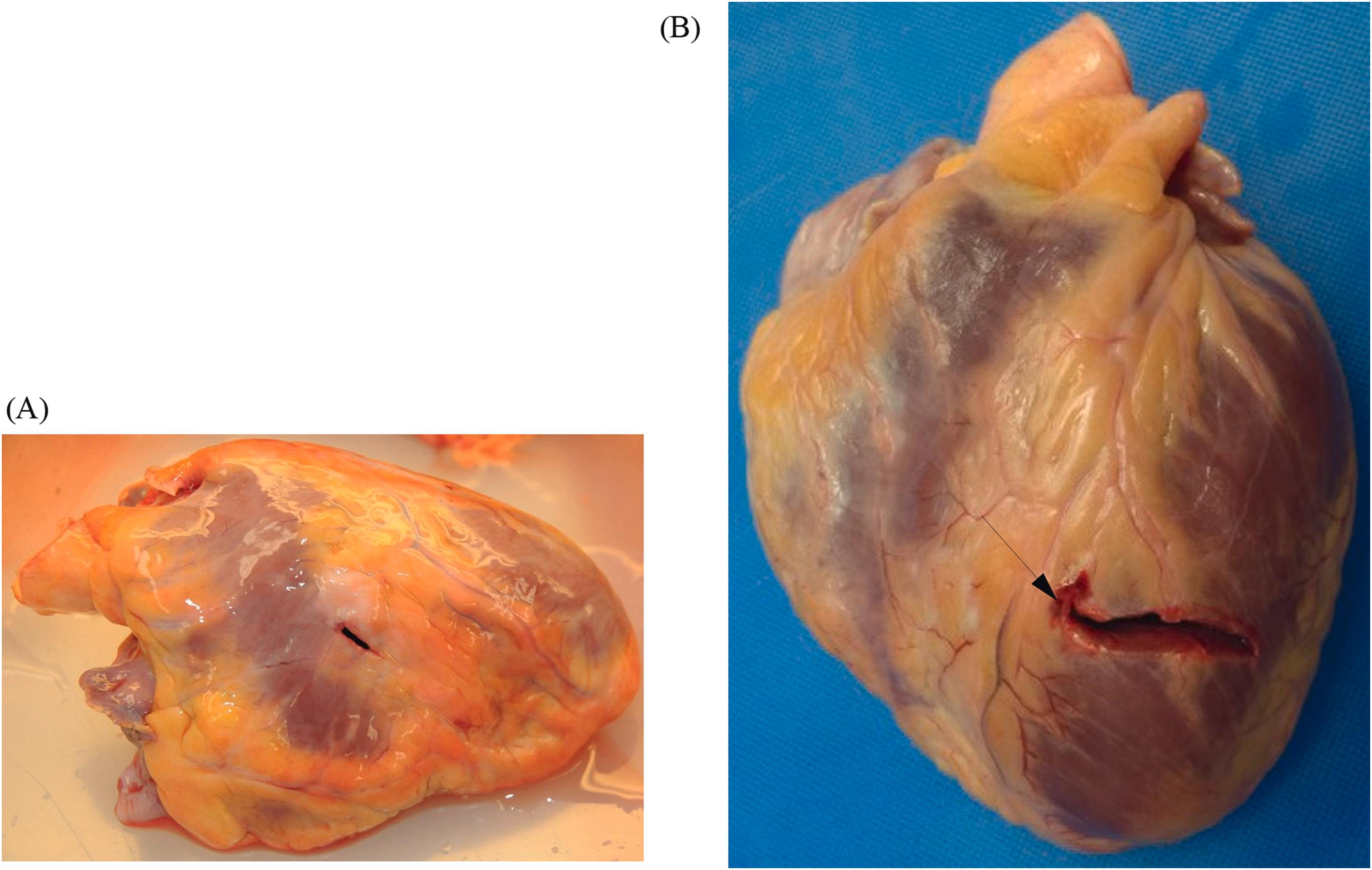
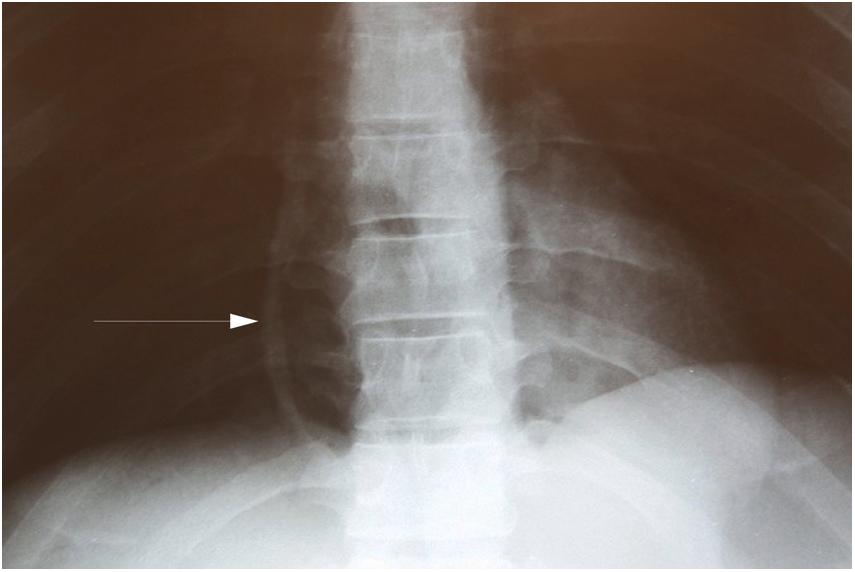
Gunshot wounds vary in the extent of injury, with smaller caliber bullets generally causing less damage to the heart than larger caliber bullets, and rifle wound injuries being much more extensive than those sustained from handguns. The damage to the heart is a result of the amount of energy the traveling bullet releases into the tissue as it traverses. The more gunpowder in a projectile, the more energy the bullet has to transfer to the tissues, and the greater the damage. A handgun typically causes a small- to medium-sized perforation in the heart while a rifle will cause pulpification of the myocardium ( Fig. 22.6 ). Shotgun wounds of the heart vary based on how close the shotgun is fired to the body. The closer the shotgun is to the body when fired, the tighter the distribution of the pellets, and the more they travel together as one object causing a large defect with a smooth to scalloped margin. The further away from the body when fired, the more spread out the pellets become and the pattern of injury will be smaller, punctate defects approximating the size of the pellets . Injuries of the blood vessels can occur from direct perforation or secondary damage from a bullet passing close to the vessel ( Figs. 22.7 and 22.8 ).
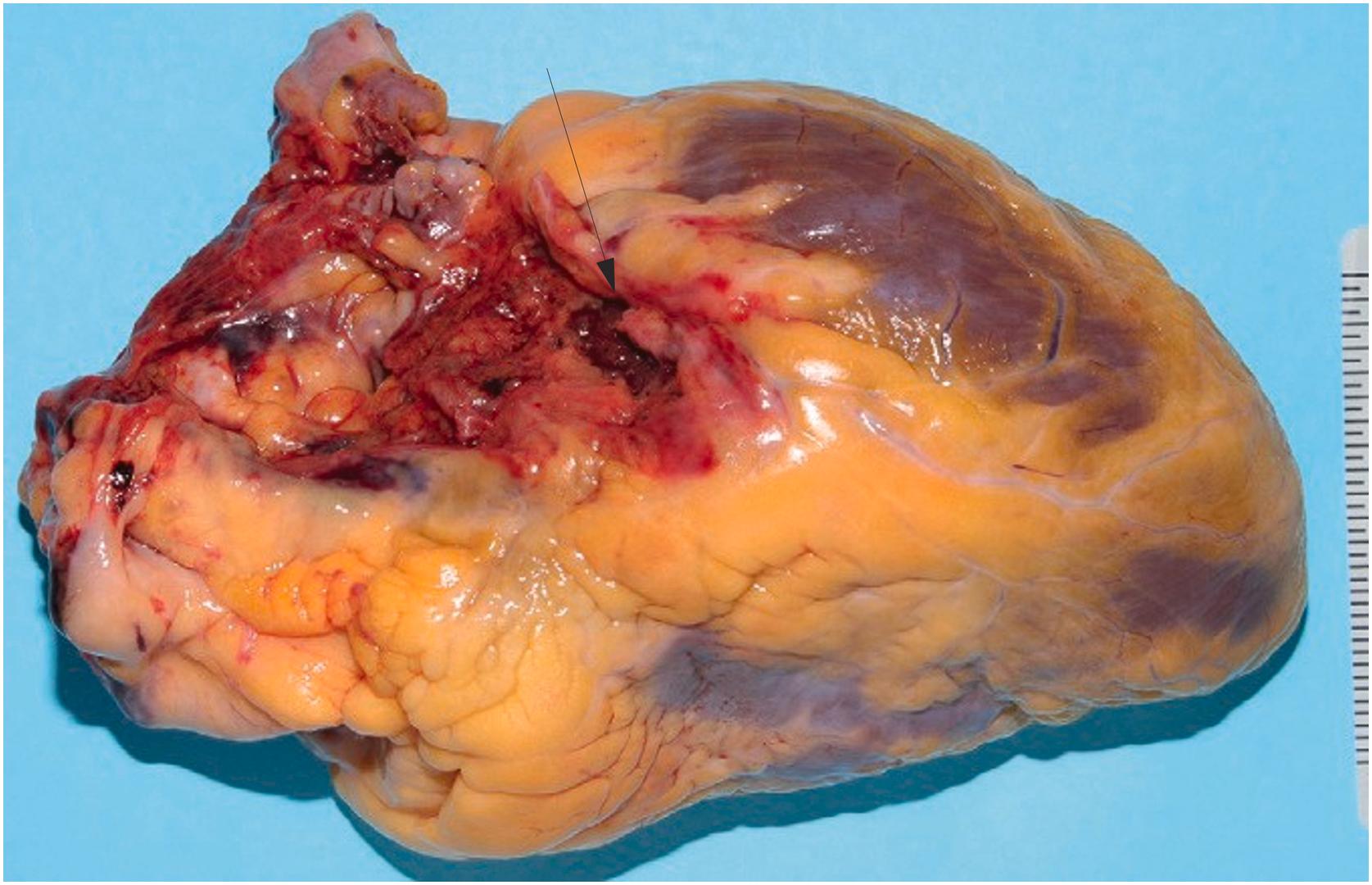
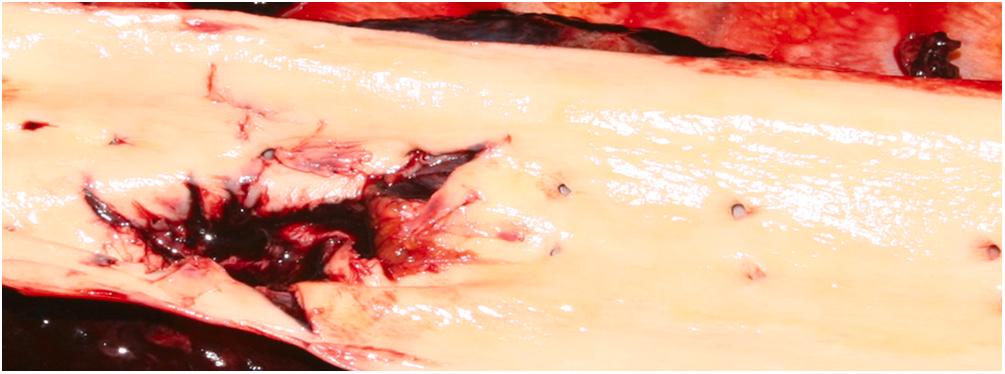
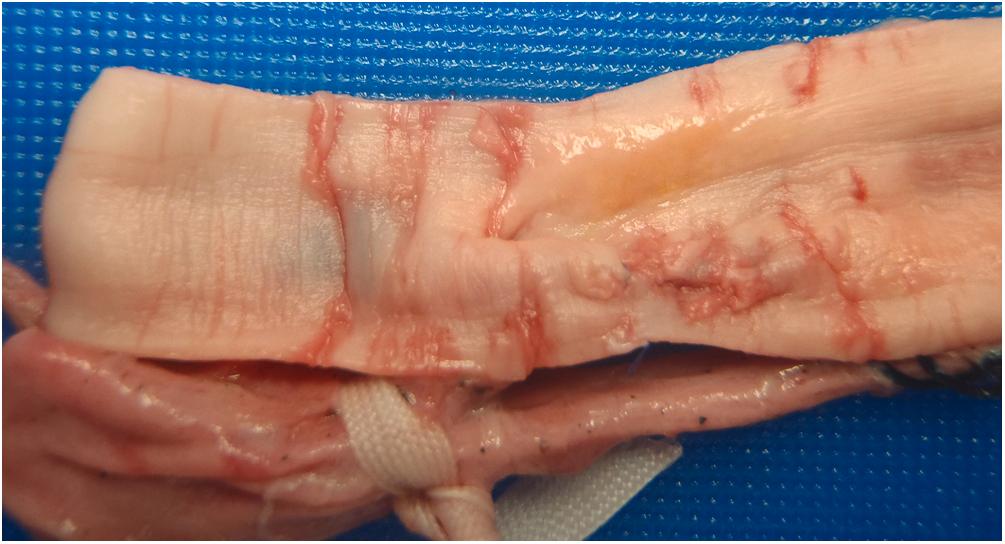
Blunt force trauma of the heart and vessels results from direct impact or acceleration–deceleration forces . Direct impact injuries may be from an object striking the chest, such as a baseball, or from the torso impacting a hard object or surface, such as steering wheel. Acceleration–deceleration injuries occur when the body, moving at a high velocity, strikes a fixed object; although the motion of the body is stopped, the internal organs continue to move, and may have changes in velocity at differential rates resulting in lacerations depending on the tethering points of individual structures and the properties of the individual tissues. Resultant trauma, causing injury or even death, may be as minimal as no gross or microscopic evidence of injury, as in a commotio cordis (a phenomenon in which a sudden blunt impact to the chest causes sudden death in the absence of cardiac damage), or as extensive as focal rupture of the cardiac muscle . Occasionally, the heart may even be expelled from the chest when gaping lacerations of the skin and chest wall are present. Such extensive injuries are most often seen in high-speed motor vehicle and motorcycle crashes where there are extensive blunt force injuries ( Fig. 22.9 ). Additionally, small aircraft collisions may result in extensive injuries of the heart and vessels, both from impact and from fragments of penetrating debris ( Fig. 22.10 ). Contusions of the heart result from direct impact or compression of the heart and may occur on the anterior or posterior surface of the heart. Concurrent injury to the skin, soft tissues, and bones need not be present. Contusion may be present on the epicardial surface, through the full thickness of the myocardial wall or on the endocardial surface . However, endocardial hemorrhages are more commonly associated with reperfusion injury. Care should be taken to microscopically examine such lesions when related to the cause of death. Contusion may cause pain simulating angina pectoris or myocardial infarction, but may remain undetected and asymptomatic. Microscopic examination of the contusion reveals abundant interstitial hemorrhage with variable findings, including contraction band necrosis and damage to muscle bundles. Similar to a resolving myocardial infarct, healing of a contusion with necrotic softening renders the wall weak and prone to rupture with resultant hemopericardium and cardiac tamponade. Replacement fibrosis is the end result of a healed cardiac contusion and, if large, a posttraumatic aneurysm may form .
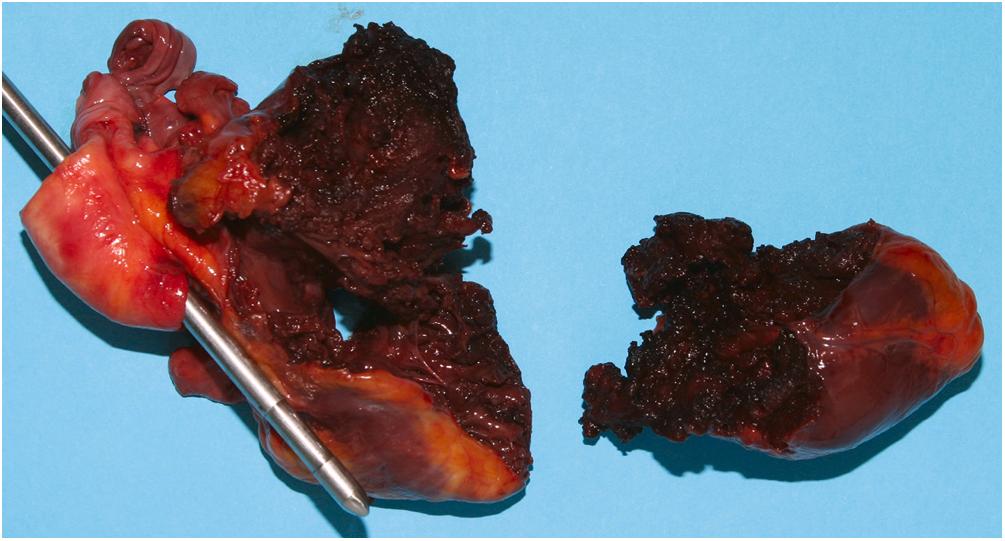
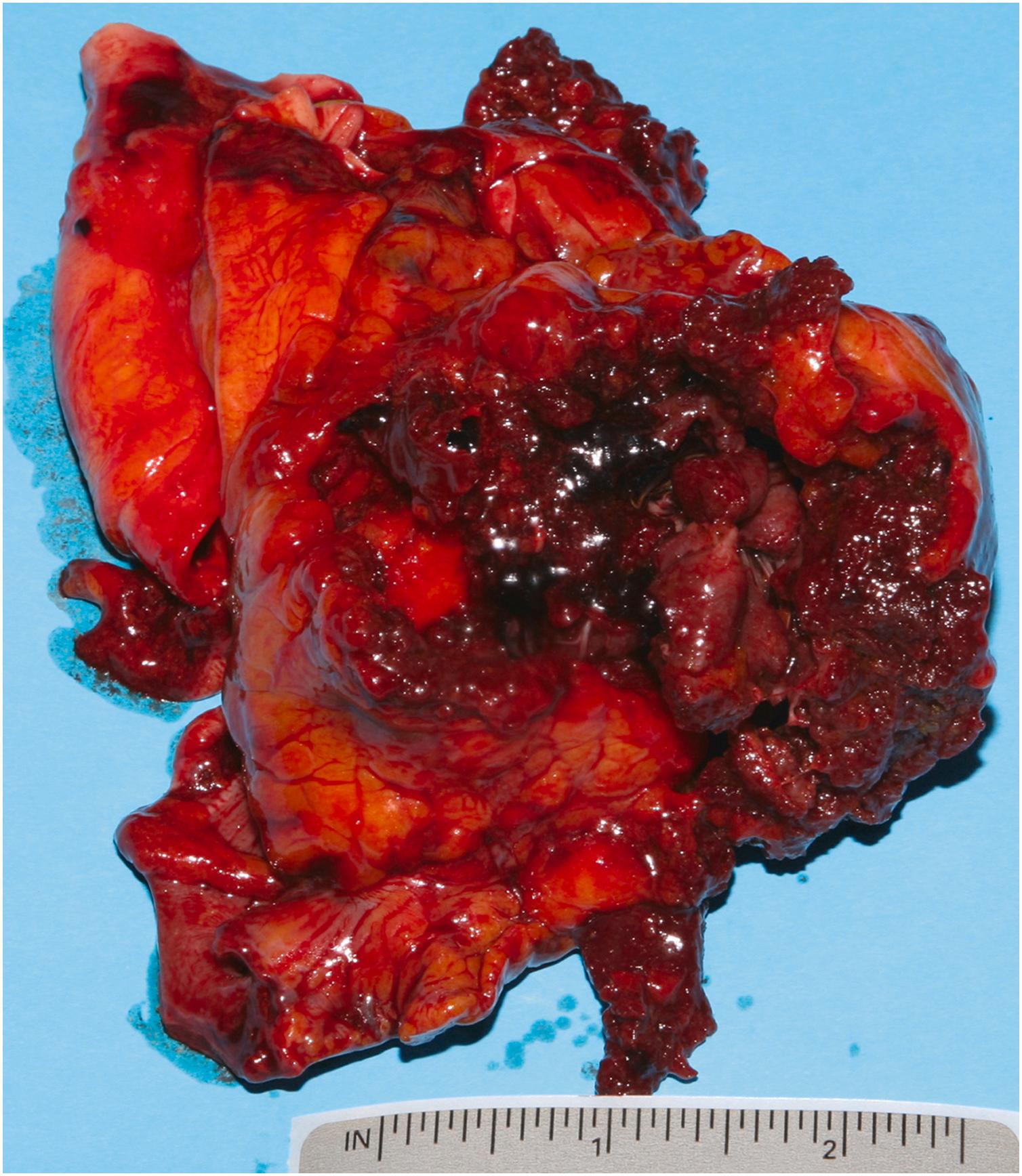
Falls or jumps from great heights, such as descent from a tall building, often lead to extensive fractures of the ribs, sternum, and vertebral column which may displace and cause secondary injuries including hemorrhage of the soft tissues, contusion of the myocardium, and puncture lacerations of the heart and vessels. The deceleration forces may also cause primary lacerations to the pericardium, heart, and great vessels . Lacerations may be small and focal or large and gaping ( Fig. 22.11 ). The vast majority of aortic lacerations and transections occur in the thoracic segment 2–3 cm past the origin of the left subclavian artery at the aortic isthmus. It is at this location where the aorta is most fixed by the ligamentum arteriosum, resulting in a focus of increased stress during deceleration. The second most common site of aortic laceration is just proximal to the innominate artery in the ascending aorta, another relative point of fixation. A partial thickness laceration of the intima or media may lead to a posttraumatic aneurysm which may remain undetected while contained by pressure from surrounding anatomic structures or may continue to expand, causing pain as it presses on surrounding structures. Margins of an aneurysm located at the site of the laceration may cause a coarctation and disrupt blood flow past this site . A partial thickness laceration with maintained circulation may also result in retrograde or antegrade dissection of the aortic wall, causing occlusion of the intimal lining of the aorta or coronary artery and sudden death . Injuries similar to those discussed in the aorta can occur in the branches of the aorta or in the peripheral arteries, with similar pathologic sequelae . Injuries to peripheral veins often lead to thrombotic occlusion with infarction of dependent tissues and organs . Nonpenetrating blunt trauma may also damage the coronary arteries and cardiac valves . Lacerations of the intima and media may lead to local thrombosis or dissection resulting in myocardial ischemia. The left anterior descending coronary artery is most commonly involved, likely due to a location of vulnerability to blunt impact in the anterior chest. Lacerations of the cardiac valve leaflets and avulsion at points of attachment, as well as rupture of the chordae tendineae and papillary muscles, may lead to valvular insufficiency and even infective endocarditis . The aortic valve most commonly experiences lacerations and avulsion of the leaflet attachments, while the chordae tendineae and papillary muscles of the mitral valve tend to incur damage. Both native valves and mechanical and bioprosthetic valves may be subjected to damage in blunt impact trauma .
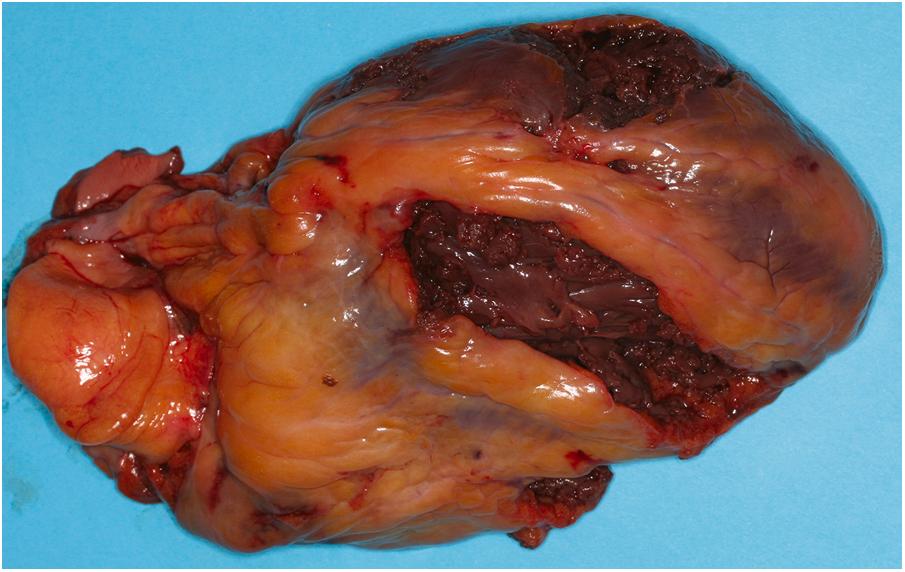
Identifying death from commotio cordis is heavily dependent on documentation of witnessed or circumstantial blunt impact to the chest without gross or microscopic injury of the heart identified at autopsy ( Figs. 22.12 and 22.13 ). Typically, injuries to the soft tissues and bones of the chest are absent to minimal and should never be extensive enough to cause death . A thorough scene investigation may make the difference between determining death due to commotio cordis and an undetermined cause of death. Details surrounding death should be thoroughly documented, particularly extensive explanation of the activities before and after collapse. Multiple witness accounts should be gathered when a decedent was engaged in a sporting activity during collapse, particularly those with hard objects such as baseballs, lacrosse balls, and hockey pucks . Decedents involved in motor vehicle crashes where there is possible chest impact should be examined for signs of cardiac activity after death. A lack of blood at the scene in a decedent with injuries that would be expected to bleed should raise suspicion for a sudden loss of cardiac activity and the possibility of commotio cordis. A sudden collapse during horseplay or wrestling should also raise suspicion for commotio cordis. Correlating negative autopsy findings, including histopathology, toxicology, and if appropriate molecular genetic testing for cardiac channelopathies and cardiomyopathies, with a blow to the chest will allow one to make the diagnosis of commotio cordis ( Fig. 22.14 ). Chest impacts leading to commotio cordis typically occur to the anterior chest wall over the heart and must occur at a very specific point in the cardiac cycle to cause ventricular fibrillation and death. Pig studies have shown that chest impacts with a baseball-type object caused commotio cordis if the impact occurred during a 30 ms window on the upslope of the T-wave, just before the peak. This represents the repolarization phase of the cardiac cycle. The most common cardiac dysrhythmia experienced is ventricular fibrillation . Cardiac dysrhythmias from witnessed chest impacts followed by unresponsiveness may be reversed with quick use of automated external defibrillator (AED) devices. AEDs are most effective when utilized within 3 min of collapse and readily available AEDs at sporting events has become the rule rather than the exception. While resuscitation was once believed to be futile, survival is now reported in 35% of reported cases .
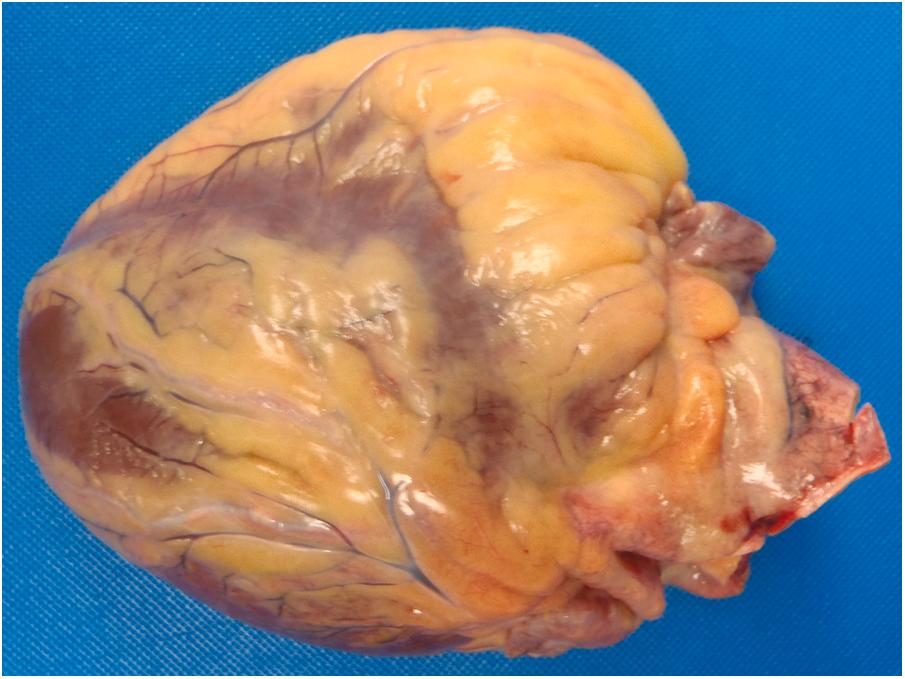
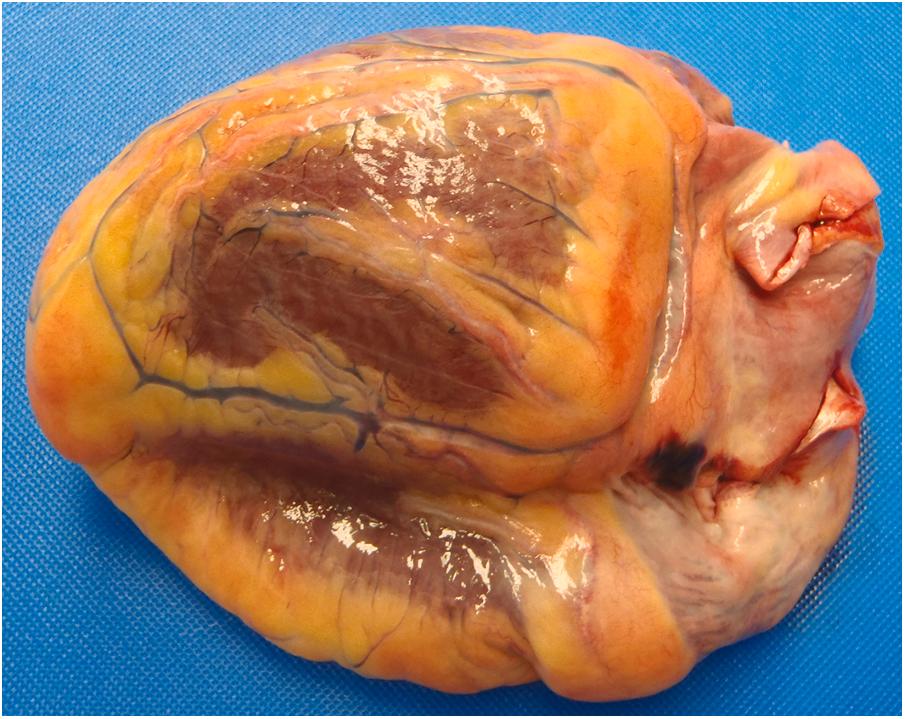
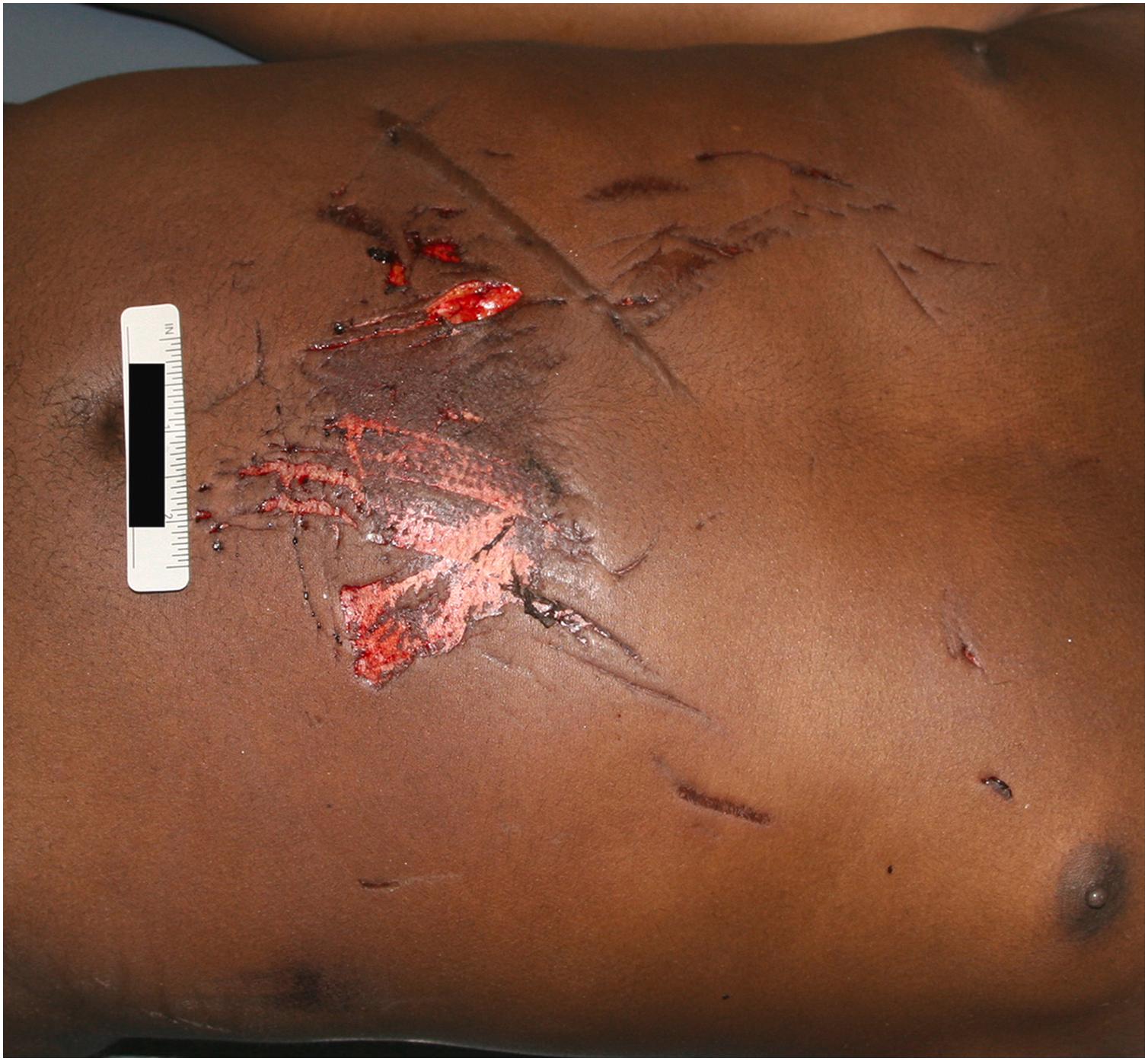
With current medical advances, most cardiac congenital anomalies are identified at a very young age and are successfully treated. In those who die from the anomalies, their deaths typically do not fall under the jurisdiction of the coroner or medical examiner, as the cause of death is natural and related to their previously diagnosed congenital heart disease. In cases of sudden unexpected death, congenital defects are typically readily identified at autopsy. However, more subtle or rare anomalies may be identified only upon consultation with a cardiac pathologist. Occasionally, death occurs suddenly and unexpectedly after a period of time following successful repair of a known congenital defect from which long-term survival was expected. In such cases, the death typically does fall under the jurisdiction of the local coroner or medical examiner and an autopsy should be performed to determine the cause of death. It is often helpful to review operative reports and if possible, to have the surgeon present for evaluation of the heart, to better understand the procedure, and receive immediate feedback regarding the state of the repair . Once out of the adolescent period, sudden death due to a congenital cardiac anomaly is rare, though ventricular and atrial septal defects may be identified in older adults who have managed to remain undiagnosed and compensate for the defect until the heart becomes enlarged and a cardiac dysrhythmia occurs, causing sudden death . The threshold to consult a cardiac pathologist for gross or microscopic examination should be low, particularly in cases of complex congenital anomalies or rare genetic disease processes.
Cardiomyopathies are covered at great length elsewhere in this book, but here we highlight the most common causes of sudden and unexpected cardiac death related to cardiomyopathies . Dilated and hypertrophic cardiomyopathies are the most prevalent types identified in SCD. Arrhythmogenic right ventricular cardiomyopathy (ARVC) is a less commonly identified cardiomyopathy, but should be excluded in all cases of SCD. Dilated cardiomyopathies alter the normal muscular function of the heart leading to a variety of physiologic compensatory changes and death typically results from dysrhythmia, conduction system abnormalities, or secondary effects of heart failure . Identification of cases in which saving genetic material may be helpful can be complex, but in sudden death where a cardiomyopathy in the decedent is known, a family history of cardiomyopathy is known, or autopsy findings suggest a genetic cardiomyopathy, samples should be collected. It is best to err on the side of caution and collect material for potential genetic studies even if subsequent analysis is later deemed unnecessary.
Dilated cardiomyopathies are commonly identified at forensic autopsy. Death may be seen at any stage of the progressive process of cardiac enlargement, ventricular chamber enlargement, thinning of the left ventricular wall, and contractile dysfunction. The heart enlarges primarily from systolic failure, though diastolic failure also occurs. Dilatation can lead to progressive dysfunction of the tricuspid and mitral valves, manifesting as regurgitation. Despite efforts to compensate for the dysfunction, the heart eventually sustains too much damage to maintain adequate cardiac function. A variety of underlying etiologies for dilatation are well known, but in the forensic population of sudden death, alcohol and hypertension are the most commonly identified underlying etiologies ( Fig. 22.15 ). Dilatation from unreported or undiagnosed remote myocarditis is also seen. Much less common are genetic mutations leading to familial dilated cardiomyopathy .
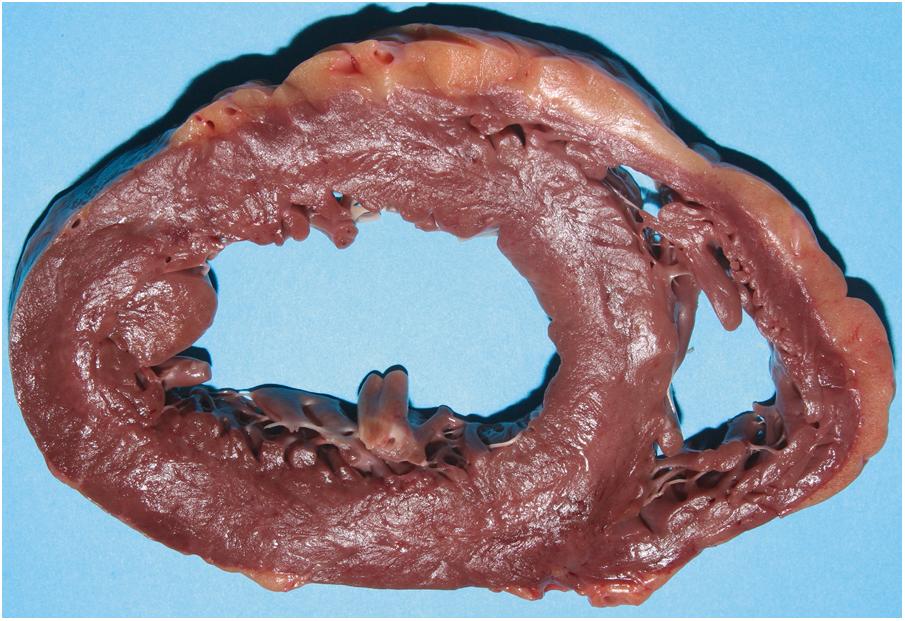
Occasionally, antemortem symptoms are reported including fatigue, dyspnea on exertion, and edema. Often, there is no history of such symptoms and clues must be gathered during the external examination and examination of the body cavities and organs at the time of autopsy. Lower extremity edema, pulmonary edema, and increased serous fluid in body cavities can be observed at autopsy. A thorough medicolegal investigation may reveal a history of known cardiomyopathy or the presence of medications suggestive of treatment for congestive heart failure, including angiotensin-converting enzyme inhibitors, angiotensin II receptor blockers, beta-blockers, diuretics, and vasodilators. Investigation may also reveal medications indicating a possible underlying etiology of the cardiomyopathy, for example, antihypertensive medications. The presence of numerous alcoholic beverages and/or medications such as folate and vitamin B12, can suggest a history of chronic alcohol use disorder.
Thorough examination of the organs at autopsy may also reveal clues for underlying etiologies. Identification of hepatosteatosis or hepatic cirrhosis at autopsy would support ethanol as the underlying etiology. Arteriolonephrosclerosis suggests a history of hypertension ( Fig. 22.16 ). The presence of a billowing mitral valve with myxoid degeneration is consistent with mitral valve prolapse (MVP). Fibrosis and thickening of the valve and chordae tendineae indicate long-standing prolapse ( Fig. 22.17 ). Histopathologic examination may reveal patchy fibrosis suggestive of a remote viral myocarditis. Because alcohol is cardiotoxic, its cardiovascular effects in addition to cardiomyopathy include arrhythmias, hypertension, and stroke. Binge drinking has been shown to cause myocardial inflammation. While chronic alcohol use disorder is identified more frequently in men than women, women tend to suffer the cardiotoxic effects of alcohol more commonly than men, despite consuming a lower quantity than men. Cardiomyopathy from chronic alcohol use disorder and sudden death may still occur in persons abstinent from alcohol if they have suffered irreversible or progressing myocardial damage from past alcohol consumption. Lack of present overconsumption of alcohol or presence of alcohol containers upon medicolegal investigation should not exclude alcohol as the underlying etiology of the cardiomyopathy. In such cases, a history of past alcohol misuse provides sufficient evidence . Rarely, the cause of the dilated cardiomyopathy cannot be identified . Less common causes of cardiomyopathy include doxorubicin chemotherapy treatment, collagen vascular disease, starvation, endocrine diseases, drugs such as cocaine, heavy metals, granulomatous disease such as sarcoidosis, neuromuscular disorders, and the peripartum period. A complete medicolegal investigation combined with findings from a complete and through autopsy will often allow for identification of these underlying etiologies. Occasionally, despite extensive efforts, a likely cause may not be identified .
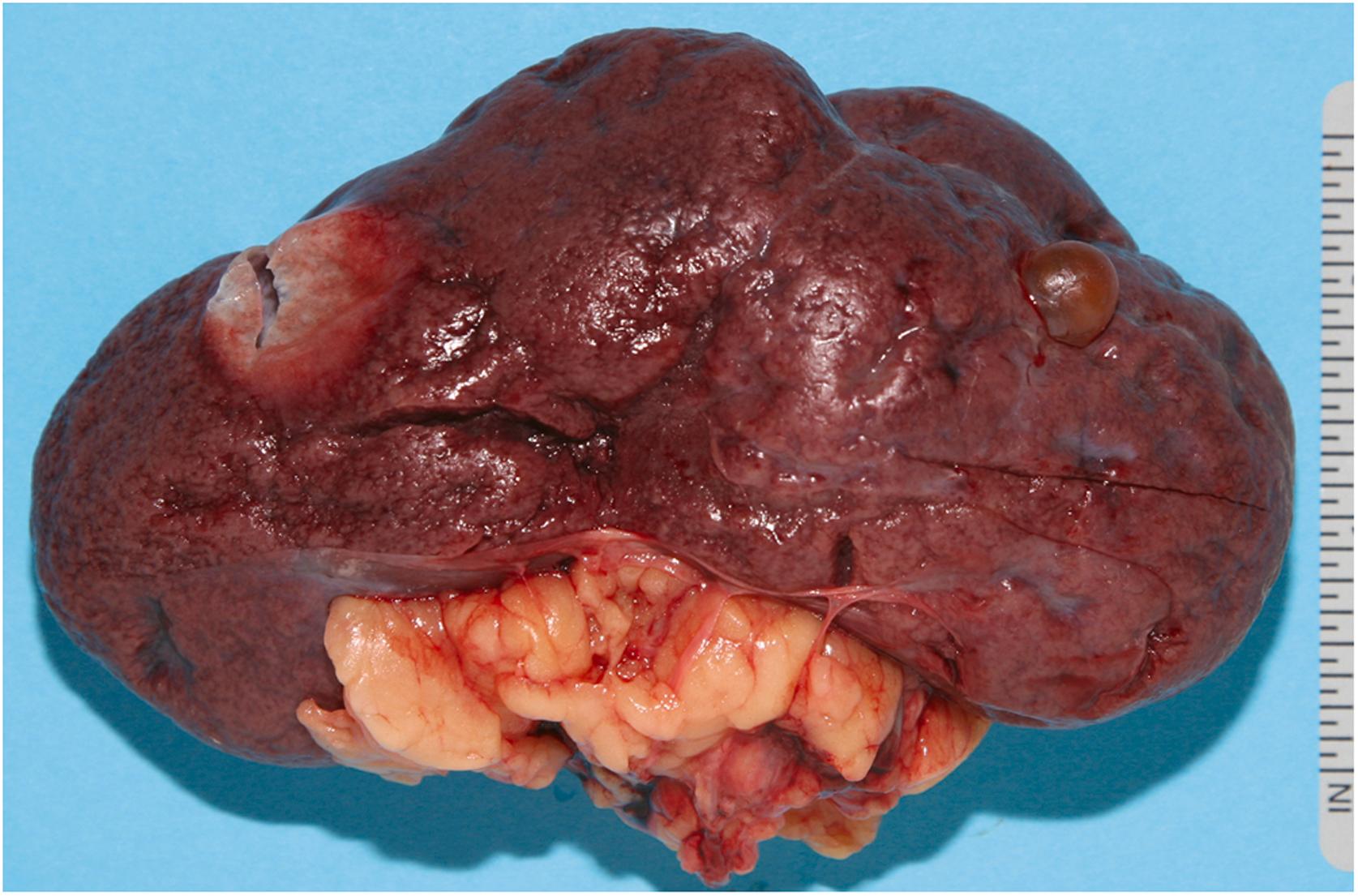
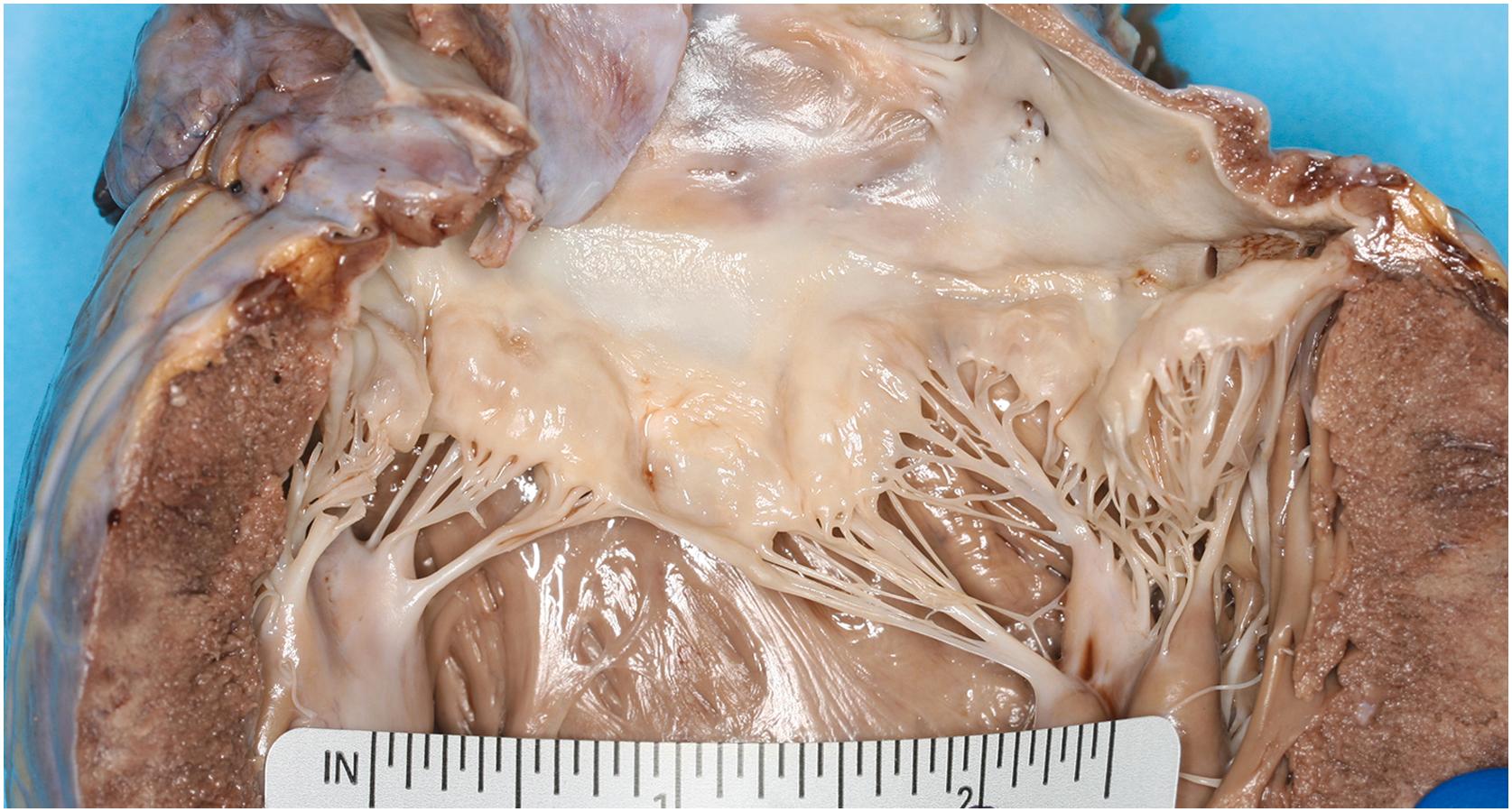
Hypertrophic cardiomyopathy (HCM) is a widely recognized cause of sudden death in the preadolescent, adolescent, and young adult population, often without antemortem symptoms or diagnosis. While both males and females may be affected, the typical forensic scenario is a teenage male participating in a vigorous sporting activity who suddenly collapses and cannot be resuscitated ( Fig. 22.18 ). Most patients are asymptomatic, and the first presentation of disease can be sudden death. When present in females, the disease typically presents at a younger age, with symptoms, and is medically evaluated. At autopsy, the heart is enlarged, and the interventricular septum is typically disproportionately enlarged in comparison to the left ventricular free wall. Cutting the heart to show a four-chamber view will allow for the most obvious identification of this discrepancy . Occasionally, the free wall and the interventricular septum may be symmetrically thickened, or the free wall may even be thicker than the interventricular septum. The risk of sudden death in HCM patients is high, even if the left ventricular wall and interventricular septum thickness is not marked. Extensive histologic sections should be taken. Microscopic examination reveals myocyte disarray or disorganization, particularly high in the interventricular septum, but disarray may also be identified in the left ventricular free wall. Fibrosis is often present and may be identified both grossly and microscopically. Intramural coronary arteries with a thickened wall and reduced lumen may also be observed . Subendocardial fibrosis from ischemia may be identified. Endocardial fibrosis occurring over the septum immediately subjacent to the aortic valve is typically present, as well as a patch of fibrosis in the subaortic mitral region due to sustained repetitive impacts . While consultation with a cardiac pathologist is not necessary, benefit may be gained from an extensive evaluation of the coronary vessels and structural documentation of the heart. Since HCM is a genetic disorder known to have a high incidence of sudden death and living relatives may also be affected, fresh postmortem samples should be collected and saved for potential future genetic testing. Identification of HCM at autopsy may prompt testing of relatives for HCM and, if identified, lives can be prolonged through medical intervention including medication and adjustment of activities of daily living .
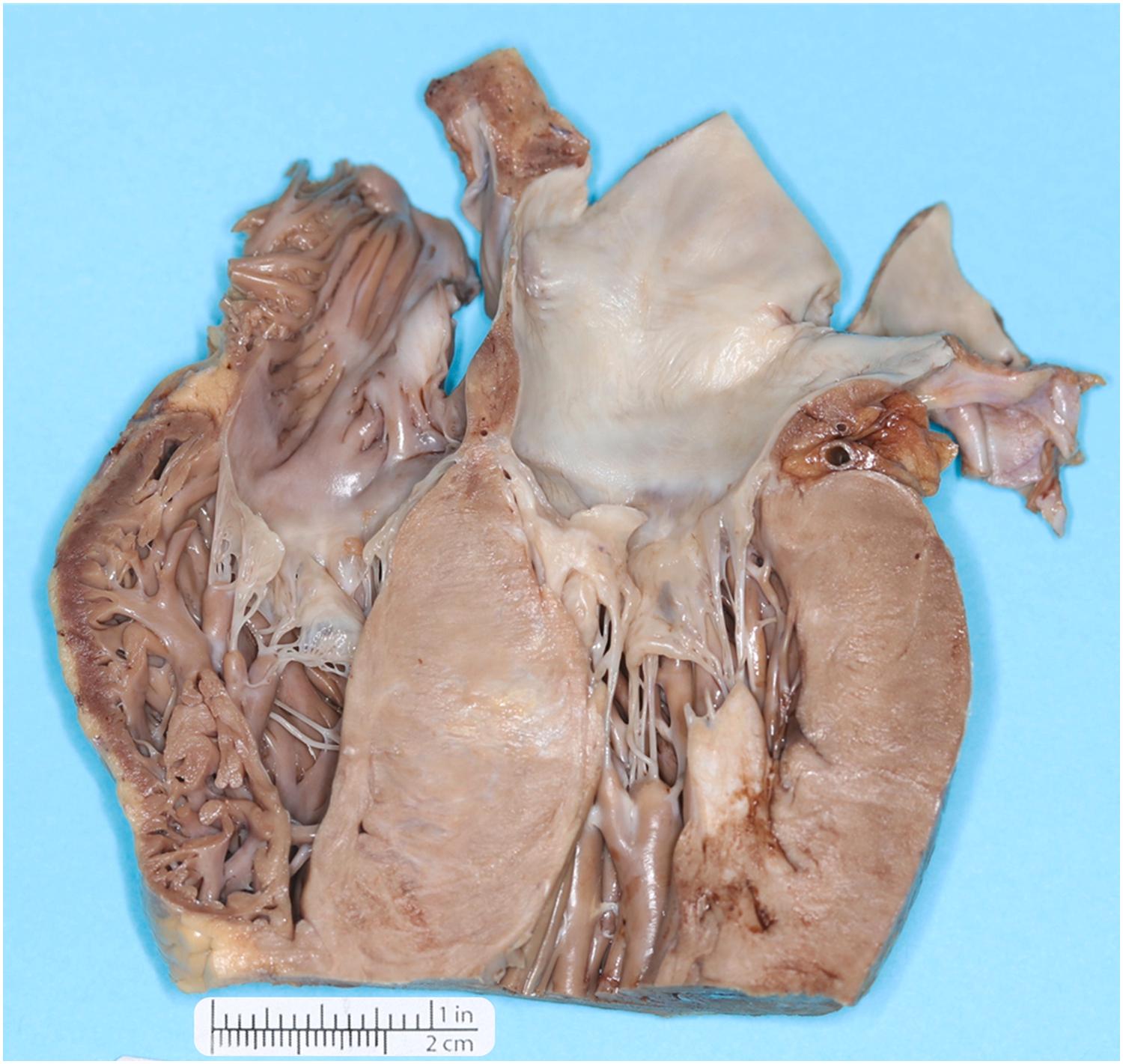
ARVC manifests with gross or microscopic fibrofatty replacement of the right ventricular myocardium. ARVC can manifest with sudden unexpected death from postadolescence to age 50. At autopsy, the right ventricle may exhibit extensive fibrofatty replacement of the right ventricle such that the wall is translucent when held to light. However, cases may be missed exclusively on gross examination. Thorough sectioning of the heart, including sections of the right ventricle, in cases of sudden death when routine investigation, toxicology, and histology do not illicit an underlying cause of death may help to identify grossly inapparent cases of ARVC .
Become a Clinical Tree membership for Full access and enjoy Unlimited articles
If you are a member. Log in here